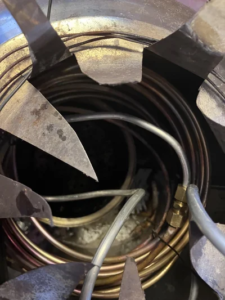Turning Waste Heat into Electricity: DIY Steam Generator Using Biochar Stove (TLUD) and Tesla Turbine for Off-Grid Electricity



A huge amount of heat is typically wasted during biochar production – but what if you could turn that waste heat into clean, renewable electricity? This DIY steam generator system captures that unused energy using a TLUD (Top-Lit Updraft) biochar stove, a monotube steam boiler, a bladeless Tesla turbine, and a simple DC motor to generate power. Whether you’re heating your home, making biochar, or camping off-grid, this setup lets you produce electricity using just water – which can even be recycled through a basic condenser.
Safety note: Steam systems can reach dangerous temperatures (over 100°C) and pressures (up to 100 psi). The monotube design improves safety, but always wear protective gear – including gloves, goggles, and earplugs. A broken seal at high pressure is loud and potentially harmful.
Supplies


No welding is needed – just sheetmetal, 6mm tubing and misc plumbing parts. Full update supply list is available here (Click the images on the list for links to the product)
🔧 Step 1: Choose the Right Fire Pit and Tubing for Your DIY Steam Generator


For this small DIY steam system, I used a 9-inch diameter smokeless fire pit as the heat source. However, any consistent heat source will work. It’s important to ensure the tubes remain above 200°C (392°F) when producing steam to maintain efficiency and safety.
For tubing, 6mm copper tubes are ideal due to their excellent heat conduction and high-temperature tolerance. Aluminum tubes also work but are more fragile. Galvanized steel tubes (such as brake lines) are a more affordable alternative, while stainless steel tubes are the most durable and offer the longest lifespan for a steam and electricity generator.
A 6mm diameter is a commonly available and reliable size. For this setup, I used 20 meters of tubing. I haven’t yet tested the minimum effective length or optimal capacity, but power output likely depends on factors such as:
The temperature of the tubes
The heat transfer rate into the tubes
The efficiency of heat transfer into the water
You can expect system pressures of up to 100 psi. For steam generator safety, include at least two pressure relief valves rated at 100 or 125 psi. Although the tubes can handle higher pressures, maintaining pressure around 80–100 psi will extend the lifespan of your turbine, joints, and valves.
🔧 Step 2: Coil Tubes for Efficient Steam Flow



Coil the tubes so that water enters at the top of the stack and steam exits at the bottom—where the steam is hottest. This layout maximizes heat utilization and improves steam output in your DIY steam generation system.
Whenever possible, ensure the tubing maintains a continuous downward slope. This helps during startup by preventing trapped pockets of water, which can impede steam flow and delay pressure buildup. A sloped design supports efficient startup and smoother overall operation.
🔧 Step 3: Add Pressure Control and Safety Features

Include a one-way valve, a pressure gauge, a shut-off valve, and a pressure relief valve at the point where water enters the system. I use water from my domestic supply, which is pressurized at 70 psi.
The incoming water pressure must be higher than the system pressure to allow safe and effective water entry. Fortunately, you’ll need to add only a very small amount of water because once it’s converted into steam, it expands by approximately 40 times its original volume—this is known as the steam expansion ratio.
⚠️ Safety Note:
Avoid using tanks or large-diameter pipes in this setup. 6mm tubes operating at 100 psi store relatively little energy, making them safer to work with. In contrast, 2-inch diameter pipes at 100 psi hold significantly more energy and, if they fail, could cause serious damage. Always prioritize steam boiler safety in your design.
🔧 Step 4: Control Steam Flow Into the Turbine


After the coil and before the turbine, install a pressure relief valve, a pressure gauge, and a needle valve. This setup allows you to precisely control the rate of steam flow into the turbine, which is critical for both performance optimization and equipment safety.
The needle valve offers fine-tuned steam flow adjustment, ensuring the turbine operates efficiently without being overloaded. Meanwhile, the pressure gauge and relief valve provide real-time pressure regulation and turbine protection, helping to avoid dangerous pressure build-up and extending the lifespan of your components.
🔧 Step 5: Add High-Temperature Insulation for Heat Retention

This is the completed system before insulation is added, which helps retain heat and improve overall efficiency.
While fiberglass insulation is commonly available, it cannot be exposed to open flames or extremely hot surfaces. For better thermal performance and safety, consider using rock wool insulation, which is more suitable for higher temperatures.
For the most demanding applications, especially those involving direct flame exposure, ceramic insulation is ideal. These materials are often rated up to 2000°C and offer excellent fire resistance, making them perfect for biochar stoves and steam-based power generation systems.
🔧 Step 5: Add High-Temperature Insulation for Heat Retention


Install a temperature meter on the tube exiting the coil to effectively monitor the system during operation. You can expect temperatures of up to 150°C as pressure builds within the tubing.
Once steam is produced, direct it to the turbine, which drives the electric generator. In this prototype, I used a 12-volt motor from a water pump as the generator. While this setup works for a basic DIY steam generator, you’ll achieve significantly better performance and higher efficiency using a purpose-built generator designed specifically for steam-to-electricity conversion.
Here are two short videos showing parts of the build and setup process:
Want more? We’ve added many more DIY how-to, case studies, and project walkthroughs like this for every type of waste at the Waste Free ’23 University:
🌍 https://wastefree23.org/wastefree_university/
Explore, learn, and build your own sustainable energy systems!
Got questions?

